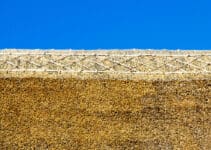Thatched roofs are made of straw, grasses, or reeds. They are still used in many parts of the world.
There are many advantages to having a thatched roof, for example like the fact that it doesn’t need to be replaced often and it contracts and expands with the weather.
But there are disadvantages too. This article talks about one major disadvantage – do mice live in thatched roofs? Unfortunately the answer is yes – but in this article we show how to prevent and get rid of them the best way you can.

Do Rats and Rodents Live In Thatched Roofs?
Yes, rats rodents do live in thatched roofs. They can squeeze themselves into tiny holes and crevices because of their flexible skeletons, slim build, long tails, and large feet so getting into thatched roofs is no problem.
In fact, it is quite common for rodents to live in thatched roofs.
Why do they live there? Here are the reasons why rodents like living in thatched roofs:
- Food is one reason. These thatch animals will chew through many different types of materials to gain access to food.
- Another reason is that it is a great place with protection from predators like birds of prey, cats, and dogs.
- A third reason is that these animals find their way into the roof when looking for nesting material such as leaves, moss, or twigs which they use to build nests for themselves and their young ones.
- Yet another reason is that these animals are nocturnal which means they are more active at night. Thatched roofs provide protection from the sun during the day but provide a cool shelter at night where heat is not lost as quickly.
Thatched roofs provide a warm and safe habitat for rats and rodents, especially during the winter months. The dense and compact layers of thatch provide insulation against the cold weather, and the small openings and gaps between the thatch and the roof structure offer rats access to shelter and protection from predators.
How To Prevent Mice and Rodents From Getting In Your Roof
Luckily, there are ways to prevent roof mice and rats from getting into your thatched roof. You can cover the outside of your roof with wire netting.
Or, you can put smooth sheet metal on top of it to make a slippery surface where rodents can’t walk or climb. You also have the option of using synthetic thatching.
You can further reduce the likelihood of these rodents approaching your house by trimming any tall grasses and weeds around the perimeter of your home.
Also get rid of their food sources such as insects, weeds, and rubbish. If you feed the birds, bear in mind you may be attracting rodents too.
Remember to have all holes sealed up quickly.
How To Get Rid Of Rats In A Thatched Roof
If it’s too late and the rodents are already in the thatched roof, there are ways to get rid of them. Here are your options:
Set Up Traps Inside The Roof
Rodents are known for being easily trapped so this should be an easy solution to your problem. You can get traps like this online:
But there are humane versions if you don’t want to kill the mice. You can use this rat trap box which will stop the roof mice from rummaging around without killing it:
Invest in a Repellent
There are many types of repellents available but some examples are electronic devices that emit sound waves which create discomfort for rodents and drive them away from the area.
Smoke ‘Em Out
You can smoke them out of your roof using chemicals that are specifically meant for such a task. Obviously, take great care when doing this.
Professional Pest Control
Another option is to call a professional pest control service who have humane methods of trapping rodents using special live catch traps and then releasing them elsewhere.
Or a cheaper alternative is this repellent which I recommend:
Rats in Thatched Roofs
In summary, rodents live in thatched roofs because they’re warm, dry places where they can find safety from predators.
There are many effective ways to make sure thatch animals don’t enter your house including sealing small holes and trimming tall grasses around the perimeter of your home.
If necessary, there are also solutions for getting rid of them which include setting up traps, using repellents or calling professional pest control services.





